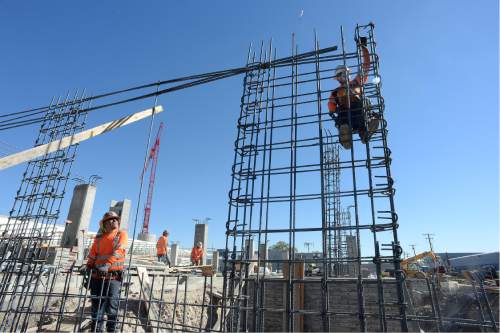This is an archived article that was published on sltrib.com in 2016, and information in the article may be outdated. It is provided only for personal research purposes and may not be reprinted.
As Salt Lake City seeks to ease its affordable-housing crunch, the problem's human dimension is coming into sharper focus.
New information suggests thousands of the city's children, single-parent families, minority residents and people with disabilities are getting trapped in poverty, their plight worsened by years of stagnant wages and rising housing costs.
And the cycle is feeding a pipeline of those vulnerable to eviction and homelessness.
"The system has really failed these people," said Mike Akerlow, director of the city's Housing and Neighborhood Development division.
Half of the city's renters are "cost burdened" by housing, meaning they spend at least 30 percent of their monthly incomes for a place to live. A quarter of them are "severely burdened," forking over half their monthly pay or more to a landlord.
Shannon High, a single mother of two, knows the story all too well.
High finally was able to apply for federal housing aid on Thursday — after three years on a waiting list. With her rent now hovering around $1,000 a month — even with roommates — the assistant manager at a social-services agency said she faces brutal choices weekly on which bills to pay.
Without a recent waiver on school fees for her sons, "we wouldn't be eating," High said. "I don't know how a person is supposed to make it on their own. I mean, I'm working and it's still a struggle."
With housing and homelessness a top priority, Mayor Jackie Biskupski and the City Council are staring at a shortage of nearly 7,500 affordable dwellings for residents earning $20,000 a year or less — a gap officials say cannot be closed without sweeping new policies and an infusion of cash.
—
Driving poverty • Similar housing squeezes are plaguing U.S. cities nationwide. But in sometimes-emotional briefings in recent weeks, Salt Lake City leaders are confronting what they see as a policy emergency, increasingly referred to as a housing affordability "crisis."
"There isn't a person sitting here who doesn't think this is really, really important," Councilwoman Lisa Adams told colleagues last week.
With housing costs as a key driver, official estimates are that 15 percent of all families and 39 percent of single-parent families within city limits live in poverty — as do 30 percent of all children.
A recent survey found about 1,000 living units lack plumbing, full kitchens or both. Some 3,265 rentals are overcrowded these days, compared with 2,240 units in 2013.
The city's vacancy rate is now between 2 percent and 3 percent, a historic low. And while the Wasatch Front is seeing a boom in apartment construction, those new units are predominantly one and two bedrooms rented at market rates, all but out of reach to those in low-wage and blue-collar jobs.
"Housing may be there," Akerlow said. "It's just that people are paying more than they should."
With land costs soaring, existing tax credits and other incentives for developers to build affordable units are no longer enough, Akerlow said. Former Mayor Ralph Becker's "5000 Doors" initiative to spur more construction has also fallen short, he said. "We're not seeing the number of units we need affecting those lower incomes."
—
What to do • The issue is likely to command much of City Hall's attention in coming months as Biskupski and the council debate new policies on land use, development and financial incentives to alleviate the problem.
"We're starting the discussion with clearly opened eyes," Councilwoman Erin Mendenhall said.
There is talk of putting a multimillion-dollar bond before voters to create a sustainable pool of money for affordable-housing projects. The city soon will consider inclusionary zoning, with the potential to require that larger market-rate residential projects include affordable units.
New zoning and tax incentives might also be tapped to spur construction of housing types in what officials call "the missing middle" between single-family homes and apartments, such as duplexes, town homes and condominiums.
Councilman James Rogers has suggested a housing-voucher program, operated through the city's Redevelopment Agency, to help keep financially distressed residents in their homes.
City, county and state leaders, meanwhile, have worked for almost two years to address a sustained surge in homelessness, with proposals for additional shelters and improved services. Councilman Stan Penfold noted that taking steps on housing affordability, though less visible than the throngs of homeless along Rio Grande Street, is just as vital.
Akerlow echoed that sentiment, saying that many cost-burdened residents are forced to live on the verge of financial catastrophe.
"We are in a situation where we aren't supporting those who need it the most," he said. "We need to focus on those who are barely making it and are one event away from homelessness."
tsemerad@sltrib.com Twitter: @TonySemerad





